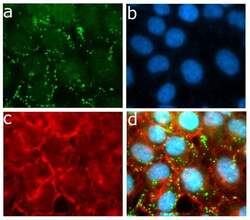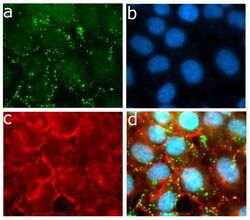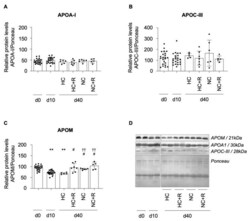Antibody data
- Antibody Data
- Antigen structure
- References [1]
- Comments [0]
- Validations
- Immunocytochemistry [2]
- Other assay [1]
Submit
Validation data
Reference
Comment
Report error
- Product number
- 710262 - Provider product page

- Provider
- Invitrogen Antibodies
- Product name
- ApoC3 Recombinant Superclonal™ Antibody (6HCLC)
- Antibody type
- Other
- Antigen
- Synthetic peptide
- Description
- This antibody is predicted to react with mouse, non-human primate, rabbit and porcine based on sequence homology. Recombinant rabbit Superclonal™ antibodies are unique offerings from Thermo Fisher Scientific. They are comprised of a selection of multiple different recombinant monoclonal antibodies, providing the best of both worlds - the sensitivity of polyclonal antibodies with the specificity of monoclonal antibodies - all delivered with the consistency only found in a recombinant antibody. While functionally the same as a polyclonal antibody - recognizing multiple epitope sites on the target and producing higher detection sensitivity for low abundance targets - a recombinant rabbit Superclonal™ antibody has a known mixture of light and heavy chains. The exact population can be produced in every lot, circumventing the biological variability typically associated with polyclonal antibody production. Note: Formerly called “Recombinant polyclonal antibody”, this product is now rebranded as “Recombinant Superclonal™ antibody”. The physical product and the performance remain unchanged.
- Reactivity
- Human, Rat
- Host
- Rabbit
- Isotype
- IgG
- Antibody clone number
- 6HCLC
- Vial size
- 100 μg
- Concentration
- 0.5 mg/mL
- Storage
- Store at 4°C short term. For long term storage, store at -20°C, avoiding freeze/thaw cycles.
Submitted references Hypercholesterolemia-Induced HDL Dysfunction Can Be Reversed: The Impact of Diet and Statin Treatment in a Preclinical Animal Model.
Schoch L, Sutelman P, Suades R, Casani L, Padro T, Badimon L, Vilahur G
International journal of molecular sciences 2022 Aug 2;23(15)
International journal of molecular sciences 2022 Aug 2;23(15)
No comments: Submit comment
Supportive validation
- Submitted by
- Invitrogen Antibodies (provider)
- Main image

- Experimental details
- Immunofluorescent analysis of ApoC3 in HepG2 cells using an ApoC3 Recombinant Rabbit Polyclonal Antibody (Product # 710262) followed by detection using an Alexa Fluor 488-conjugated Goat anti-Rabbit secondary antibody (green) (Image A). Nuclei were stained using DAPI (Image B) and actin stained with Alexa Fluor 594 phalloidin (red) (image C). Image D is a composite image showing subcellular cytoplasmic localization of Apo C3.
- Submitted by
- Invitrogen Antibodies (provider)
- Main image

- Experimental details
- Immunofluorescent analysis of ApoC3 in HepG2 cells using an ApoC3 Recombinant Rabbit Superclonal™ Antibody (Product # 710262) followed by detection using an Alexa Fluor 488-conjugated Goat anti-Rabbit secondary antibody (green) (Image A). Nuclei were stained using DAPI (Image B) and actin stained with Alexa Fluor 594 phalloidin (red) (image C). Image D is a composite image showing subcellular cytoplasmic localization of Apo C3.
Supportive validation
- Submitted by
- Invitrogen Antibodies (provider)
- Main image

- Experimental details
- Effects of diet and rosuvastatin intervention on HDL apolipoprotein levels. Changes in protein levels of apolipoproteins (APO) APOA-I ( A ), APOC-III ( B ), and APOM ( C ) in isolated HDL particles are presented as relative quantification and representative Western blots ( D ) at study endpoint. Western blot quantifications are shown as mean +- SD. Shapiro-Wilk test confirmed normality (alpha = 0.05), and data were analyzed by unpaired t-test and considered significant with a p -value < 0.05. ** p < 0.0001 in comparison to day 0; ++ p < 0.0001 in comparison to day 10; # p < 0.05 in comparison to day 40 of animals on HC diet. d0-40: day 0-40; HC: hypercholesterolemic diet; NC: normocholesterolemic diet; +R: + rosuvastatin.
 Explore
Explore Validate
Validate Learn
Learn Western blot
Western blot Immunocytochemistry
Immunocytochemistry